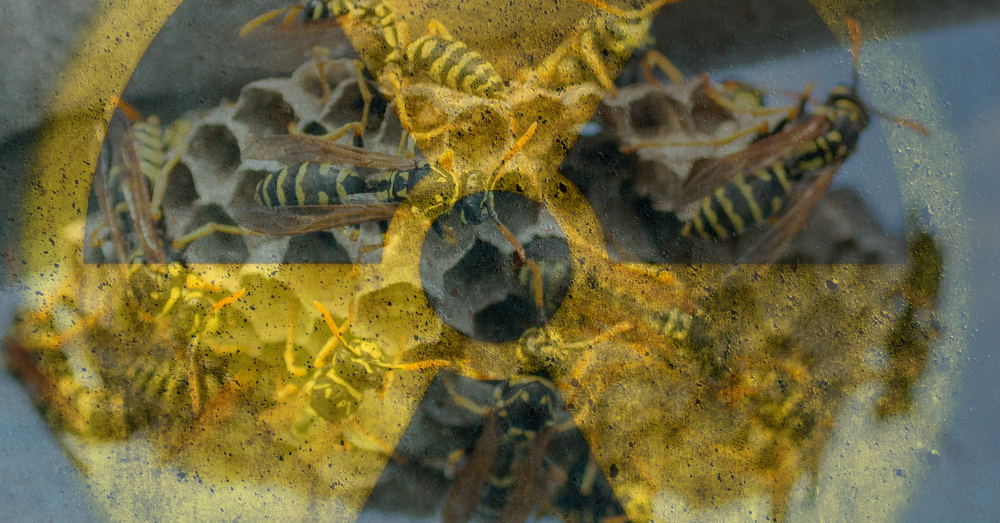
Radioactive material can be extremely harmful and dangerous, and the discovery of a radioactive wasp nest raised concerns and worry in one area.
Building nuclear weapons comes with challenges and dangers. Creating radioactive materials means having nuclear waste that must be stored. Unfortunately, you can’t simply dump the waste or have it dispersed into the atmosphere. In order to stay ahead of the rest of the world in weapons development, the United States has many nuclear sites around the country where weapons have been made and waste is stored. Recently, a strange discovery created concern in South Carolina.
The discovery
On July 3, 2025, a nest of wasps was detected at the Savannah River Site in Aiken County, South Carolina, which was once a Cold War nuclear weapons production facility now undergoing environmental cleanup. Routine radiation monitoring revealed that the nest registered radiation levels roughly 10× the federal safety limit, or about 100,000 disintegrations per minute (dpm).
Officials clarified the contamination stemmed from legacy radioactive residue, not an active leak, and that neither the surrounding area nor the public was exposed. The nest was exterminated, removed, and disposed of as radiological waste.
An incomplete report
In a world that demands full transparency, any holes in a story are often picked up and picked apart very quickly. Finding a radioactive wasp nest near a populated area can be a serious cause for concern. Are there wasps flying around with high levels of radiation that could sting people or pets and cause problems? What type of materials was the nest made of, and how did it become contaminated? Not all wasps are the same; some use dirt and others use paper-like materials to make nests.
The watchdog group, Savannah River Site Watch has since criticized the agency for not disclosing the specific source or nest materials, which could help explain how the insects became contaminated.
Tom Clements, executive director of the watchdog group felt the report was incomplete and the type of wasps should have been disclosed. He shared his worry and displeasure in a text message saying:
“I’m as mad as a hornet that SRS didn’t explain where the radioactive waste came from or if there is some kind of leak from the waste tanks that the public should be aware of.”
Why isn’t there any danger to the surrounding area?
The location of the liquid nuclear waste tanks in question is a tank farm that has specific boundaries to keep people out and protected from the possibility of exposure and a leak. Finding insects that have been exposed to radiation makes some worry because these bugs can’t be contained and might end up flying across the boundaries of the site and interact with the population outside of the tank farm.
The Savannah River Mission Completion, which oversees the site, commented that wasps generally only fly a few hundred yards from their nests. The nest was found well inside the tank farm, which is why there is no danger or worry that the wasps were able to get outside the facility and cause any issues for people in the area.
In addition to the limited flying range of wasps, finding a radioactive wasp nest is different from finding insects with radiation. The nest would be expected to have much higher levels of radiation than the insects, which might not have nearly as much contamination as their home.
How old is the nuclear weapons site?
The site in question was opened in the early 1950s to manufacture the plutonium pits required to make the core of nuclear bombs. The Cold War with the Soviet Union had begun, and trust had been lost between the United States and USSR, meaning both countries began building weapons of mass destruction, especially nuclear weapons.
During its time of operation, the site generated more than 165 million gallons of liquid nuclear waste. Thankfully, that figure was greatly reduced through evaporation, which means there’s still nearly 34 million gallons of liquid waste, which is radioactive and extremely dangerous. Currently, 43 underground tanks are still in use, but eight have been closed over the past several decades.
The area is considered safe
Those who have concerns about whether or not radioactive wasps are flying around near them shouldn’t worry. Between the limited range of wasps, the large size of the site, which is nearly 310 square miles, and the fact that the team didn’t find any wasps on the nest, it’s extremely likely that any infected wasps would have died from radiation poisoning. The nest was sprayed and destroyed, the immediate area was secured upon discovery, and there was no impact to workers, the environment, or the public.
The ground and area surrounding the radioactive wasp nest did not have any contamination, which led the Department of Energy to conclude no further action was required. While the reporting might not satisfy all parties, and some local residents might be concerned, everything points to the threat being contained. The contaminated nest was the result of legacy radioactive contamination, which is constantly present at sites like this, which is why precautions are taken and the general public is kept at a safe distance. Thankfully, this nest wasn’t the result of a contamination leak.
This post may contain affiliate links, meaning we may earn a commission if you make a purchase. There is no extra cost to you. We only promote products we believe in.






